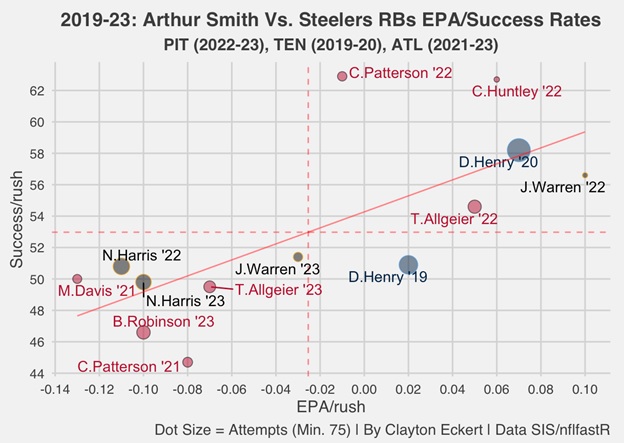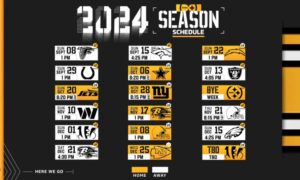I wanted to continue learning and providing data on new offensive coordinator Arthur Smith. Following articles looking at his run schemes in Tennessee (2019-2020) and Atlanta (2021-2023), today’s goal is to look at expected points added (EPA) and success rates to get a gauge the quality of results, including Pittsburgh the last two seasons for comparison.
EPA is expected points before and after each qualifying rush — in other words how many points were expected in that situation versus how many were added in the result. Success rates are 40 percent or more of the needed yards on first down, 50 percent or more on second down, and a first down or touchdown on third and fourth down.
Here is an initial view of the qualifying RBs on all rushes (min. of 75 per season):
Looking at the best results on the top right, we see RBs under Smith’s tutelage. His time with the Titans and RB Derrick Henry went extremely well, the former Alabama star securing the rushing title in two consecutive seasons, and in 2020 rushing for 2,027 yards and 17 touchdowns. These feats lead to being well above average in EPA (0.07) and success rate (58.2 percent) as expected. In 2019, Henry’s EPA was also strong (0.02), but he had a lower 50.9 success rate that landed with the rest of the pack in our sights today.
The 2022 season really stands out positively, starting with all three of his RBs in Atlanta landing above the mean in the data points. Most notable are stellar 60-plus success rates from Cordarrelle Patterson (62.9, 144 attempts) and Caleb Huntley (62.7, 76 attempts). Patterson had 695 yards (YPA) and eight touchdowns with Huntley adding another TD. Both players sported healthy 4.8 YPC.
The best result in EPA was Pittsburgh’s Jaylen Warren in 2022, with a 0.1 number on 77 attempts. That season featured 379 yards (4.9 YPC) and a touchdown en route to a 56.6 success rate as well. While 2023 was a stellar year for Warren, he landed just below the mean among this group in both, with a -0.03 EPA and 51.4 success rate, on 784 yards (5.3 YPC) and four touchdowns. This may surprise, but Pittsburgh struggled with negative runs. That and Warren tying for the second-most fumbles at the position were less than rosy examples.
Speaking of which, Steelers RB Najee Harris landed similarly and below the mean in both seasons. In 2022, he posted a -0.11 EPA and 50.8 success rate, with 1,038 yards (3.9 YPA) and seven touchdowns. His EPA was slightly better last season (-0.1) but saw a slight downtick in success rate (49.8), Harris providing a third consecutive 1,000-yard season with boosts in YPC (4.8) and touchdowns (eight).
Outside of 2022, we can see Smith’s results as the Falcons’ head coach and offensive play caller were far less ideal. This is a concerning side of the coin when anticipating the start of his Pittsburgh tenure. Atlanta RB Bijan Robinson, selected eighth overall in the 2023 NFL Draft, underwhelmed his rookie year (-0.1 EPA, 46.6 success rate, 969 yards, 4.5 YPC, four touchdowns) while Tyler Allgeier regressing following a 1,000-yard season (-0.7 EPA, 49.5 success rate, 683 yards, 3.7 YPC, four touchdowns).
In the previous studies, the findings showed that inside and outside zone were in the three most-used runs for Tennessee, Atlanta, and Pittsburgh in their respective spans. With this in mind, here are the EPA numbers for those run schemes:
Encouragingly, Smith’s RBs all remain on the top right from the first chart, all with positive EPA numbers in each scheme in 2020 with Tennessee and Atlanta in 2022. Henry’s 2019 season featured much more success in outside zone (0.18 EPA) compared to an -0.19 inside zone number.
Patterson was also above the mean on outside zone in 2021 and ’22, which Smith has run heavily. Less than desirable otherwise, and particularly discouraging, are Smith’s ’23 RB numbers, with both qualifiers having negative EPA in each scheme.
Unfortunately, not great for Pittsburgh the last two seasons. The best result was Harris’ 0.0 inside zone EPA, meaning the rest were negative numbers. Harris also had the best outside-zone result for the Steelers in 2022 (-0.08 EPA), faring better in that scheme than expected in my prior studies.
Warren did land above the mean on inside zone in 2022 (-0.01) and landed particularly lower than expected in each this season (-0.17 inside zone EPA, -0.15 outside zone EPA).
This EPA visual emphasizes the importance of a broader issue for the Black and Gold – they must score more points. Hopefully that is something Smith can rekindle in 2024, returning to prior success he had in Atlanta and with Henry in Tennessee with Pittsburgh.
Let’s dive deeper, seeing how the teams in our sights fared each season, conditionally formatting their EPA by the most common run schemes (sorted by most total attempts):
Outside zone predictably lands at the top when Smith is involved, and his units having the best results overall, highlighted by the Falcons ’22 season (0.16 EPA). That group had strong numbers in most schemes except for the less-run duo and power concepts. This visual is another way of highlighting the stronger 2020 season in Tennessee.
Smith’s outside-zone success took a dive in 2023, much closer to Pittsburgh’s worst -0.15 outside zone EPA of the group this season. Neither are what you want to see heading into 2024, considering the recency of it and it being the most attempts across the board.
With the coloring we see polar opposite EPA results overall for Smith in his last two years in Atlanta. The better results last season came in less-utilized schemes: pitch, duo, and power.
The Falcons ’23 -0.16 stretch EPA is also discouraging considering that it led their concepts in attempts last season. Pittsburgh barely touched that scheme in comparison with just 48 runs to Atlanta’s 318 over the three-year span and is a big question mark for 2024 in Pittsburgh.
The Steelers’ data is hard to digest. They didn’t lead in any run-scheme EPA along with the aforementioned outside-zone findings. Lead was Pittsburgh’s second-worst EPA result (-0.19) and was run far less than Smith in his three years with the Falcons (163 to just seven for Pittsburgh).
The Steelers’ worst EPA (-0.36) came on pitch, which was in the top five most-run schemes for Smith and the Steelers.
So, the encouraging part of the article is Smith held the best EPA number in every run scheme along with his RBs faring well in success rates, particularly in 2020 and 2022. Here’s to hoping he brings that with him to Pittsburgh for more consistency in the run game, which is greatly needed in 2024.











